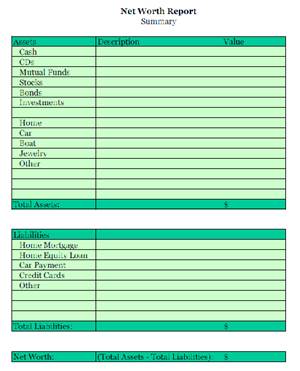No matter what you earn for an annual salary, it’s important to know what are you really worth on paper. Even if your spouse or partner handles the money, don’t skip this article. You owe it to yourself to know what you’re worth.
What does Net Worth mean?
Let’s say you sold everything you owned. Once you sold it, you also planned to pay back any outstanding balances such as mortgages or credit card balances. What’s left is your net worth.
Are you curious to find out what you’re worth? Let’s get started.
Disclaimer: This information is not meant to be financial advice. We are simply sharing information that has worked for our family. Please be sure to read our disclaimer statement. Click here
Preparation Steps to Calculating Your Net Worth
Step 1: Print our Net Worth Reports below. There are three pages: Assets, Liabilities and a Summary page.
Net Worth Report – Liabilities
Step 2: Next, pick a date for your report.
This is the date you are determining your net worth. We find that December 31st works well. Or, if it’s easier, simply pick the last day of last month.
Step 3: Gather statements from all of your accounts. This includes bank accounts, retirement plans, mortgages, and loans.
You’ll need the statements from all of your accounts to show you the ending balances as of the date you selected. So, for our example, we are looking for all bank account statements, credit card bills, and mortgage payments as of December 31st.
Tip: If you’re not sure where to start, grab your last federal income tax return. Look for:
-
Capital Gains – to show investments you hold
-
Bank interest – to determine cash in bank accounts
-
Dividend income – to find out if you own any investments like stocks or mutual funds
-
Mortgage interest paid to banks – to show any loans
Your tax return will list the names of the financial institutions where you have income-bearing accounts.
In addition, your checkbook will be helpful, or your most recent checking account statement from your bank. This will show you the names of the financial institutions where you make credit card, mortgage and car loan payments.
Once you have the names of the financial institutions, and can start to gather the necessary statements.
Compiling Your Net Worth
Assets
On the Assets page of the Net Worth Report, list everything you own. Include things like your house, car, boat, bank accounts, 401k and IRAs. Here are the main types of assets:
Cash – savings, checking, cds, money market accounts
Personal property – real estate, jewelry, cars, boats, collections
Investments – stocks, bonds, mutual funds, cash value of life insurance policies
Retirement plans – pensions, 401k, 403b, IRAs, Roth IRAs
Each item is an asset, and will need a dollar value. Bank accounts and retirement plan values can be found on your statements. To value your car, consider using Kelly Blue Book. Remember that you are not listing the amount you paid for the items, but rather what the item is currently worth.
Here is a sample of assets:
|
Asset |
Value |
| Savings | $ 18,000 |
| Checking | $ 500 |
| House | $ 150,000 |
| Car | $ 10,000 |
| 401k | $ 25,000 |
| Total Assets: | $ 203,500 |
Liabilities
On the Liabilities page of the Net Worth Report, list everything you owe. Include things like the balance on your mortgage, the balance of your car payment, and your credit card balances.
Here is a sample of liabilities:
|
Liability |
Value |
| House | $ (105,000) |
| Car | $ (2,000) |
| Credit Cards | $ (15,000) |
| Total Liabilities: | $ (122,000) |
Net Worth Summary
Finally, on the Summary page of the Net Worth Report, add up of your assets, and subtract your liabilities. This is what you are worth.
Continuing with our example:
| Total Assets: | $ 203,500 |
| Total Liabilities: | $ (122,000) |
| Net Worth | $ 81,500 |
How are you doing? A positive number indicates that your finances are healthy, and you should continue on this track. A negative number indicates that you owe more than your worth. Consider earning more income, or reducing your expenses so that you can pay off your liabilities.
Here are a few additional articles you may find helpful:
Monthly Expense Tracker: It’s not what you make, it’s what you spend
House Rules: Pay Off Your Credit Card Balance Every Month

